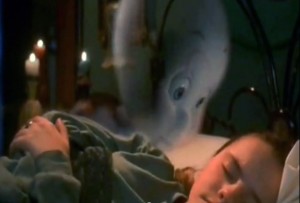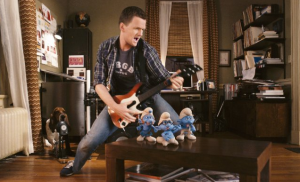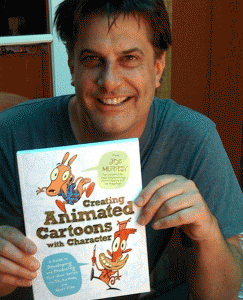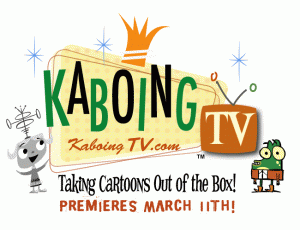Archive for category Television
CHILDHOOD REVISITED: CASPER
Posted by kjohnson1585 in Childhood Revisited, Comics, Film, Television, Uncategorized, Writing on April 4, 2011
Casper – (1995)
Director: Brad Silberling
Starring: Bill Pullman, Christina Ricci, Malachi Pearson
Screenplay by: Sherri Stoner, Deanna Oliver
Cartoonists Seymour Reit and Joe Oriolo created a phantasmagorical little boy in the 1930s named Casper, a friendly ghost who refuses to eschew the rules of the metaphysical, opting to try and befriend the mortal instead of haunting or scaring them. First as a children’s book and then as an animated cartoon, Casper’s foibles center around his attempts to communicate with people who consistently, automatically freak out and run for the hills. It’s a simple enough premise, mixing the whimsy of idealized Halloween with the creepy comradeship that the macabre can bring, all presentable for the young. And it worked; cartoons of the youthful spirit were created well into the 60s; even today, there are a ton of direct-to-DVD and simple cartoons out there. All of which were more or less spring-boarded by the 1995 film. Hope the re-watch won’t be horrifying! Etc.
NOSTALGIC LENS: I was quite effected by the film when I originally watched it, and I remembered it being surprisingly dark. It’s a difficult line to walk, trying to make a film about death and “what happens next” for kids, who certainly don’t do too much thinking about it. Still, I remember it being fun and chilling, impressed by the ghost effects, and quite enamored by the story. Boy, was I in for a trick-or-treat! Okay, I’ll stop.
DOES IT HOLD UP: When I re-watched this, my immediate first thought was, “This HAS to have been written by two writers.” Sure enough, two names appeared under the Written By credit, and it makes sense. It’s was like watching 2 separate movies in one, barely connected by a thread. One wanted to write a goofy kids film about a young specter wanting to meet a real girl and go to a school dance. The other wanted to write a dark tale of a loss, control, obsession, and shades of abuse. Instead of trying to fuse these ideas together, they just mixed and matched sections of each screenplay and plopped out a finished product. Scenes are starkly black and white in tone, instead of the smooth gray it should be.
Widower doctor (Bill Pullman) and his daughter (Christina Ricci) constantly move from place to place as the former seeks to “communicate” to his deceased wife, and the latter rolls her eyes, or something. Meanwhile, lonely ghost Casper tries desperately to befriend anyone brave enough to enter his haunted mansion, only to be scared off by his triple ghostly companions (or more accurately, owners) of Stretch, Stinky, and Fatso. MEANWHILE STILL, Cathy Moriarty and Eric Idle are two typical corporate-types who want to destroy the mansion for generic money-making scheme #8, but end up discovering a secret within the house, so they switch to generic money-making scheme #14.
Sounds messy, right? It is, but not overly so. It’s more or less three ideas told in five-to-seven minute chunks, and the ideas themselves are simple enough so it’s easy to follow. Also, the direction and editing is clean and straight-forward. Nothing special, nothing exciting, but just passable enough so as to not call anything into question – if you’re a kid.
Older viewers, however will call shenanigans on the parts that seem especially off-putting or nonsensical. For example, an early sequence has Pullman fighting the goofy ghosts with a plunger and vacuum cleaner. Funny, silly kids’ stuff, right? Well, after trapping the ghosts in the vacuum, the following scenes act as if THAT NEVER HAPPEN. Stretch, Stinky, and Fatso are suddenly freed and out and about – without any indication on how or why they were released. The idea, that Pullman is trying to talk these ghosts into “moving on,” is never exactly relayed to the trio of spooks. We’re supposed to assume this.
Balancing the dark with the goofy is never easy, but in Casper, the “dark” borders on horrifying territory. Watching Casper being physically abused by Stretch, Stinky, and Fatso comes off disturbing, not cute. A scene where those three basically ridicule Pullman’s dead wife is starkly cold. The worst thing, though, comes from the film’s attempt to utilize a piece of dialogue that works in the thematic sense throughout the film. The line? “Can I keep you?”
My “rival” is dead correct – that line is just fucking creepy. It doesn’t even really make sense. Part of me thinks its a child’s mistaken approach at romantic terminology (he sees it like one sees a pet or a toy), but the line directed at a young Ricci by a DEAD thing makes it come off much more terrifying.
There are some really nice moments, though. Casper recounting how he died is pretty heartfelt, an interesting approach to something that probably didn’t matter to the original run. And these final scenes are surprisingly dramatic: live-Casper and Ricci’s dance is cheesy good in the 90s sense, but Pullman’s revisit by his wife is actually quite powerful:
Beyond that though, there’s a lot of random moments, including the stuff with Moriarty and Idle, which doesn’t serve too much purpose, and is resolved in a silly way (there’s actually a weird moment where Casper and Ricci run from the ghost version of Moriarty, only to come back. Inexplicable.) Casper’s dual-narrative doesn’t exactly fuse together all that well, but it has moments of liveliness to combat the incomprehensible dread.
Oh, and Dan Aykroyd makes an early appearance as a Ghostbuster. That was kinda cool.
NEXT UP: Heavyweights
Smurfs, Hollywood, and the Nature of “World-Building”
Posted by kjohnson1585 in Animation, Comics, Film, Television, Uncategorized, Video Games, Writing on March 28, 2011
Hollywood will be smurfing our theaters with the new Smurfs movie, released on August 3, 2011:
I’m no longer the type of person to decry the end of Hollywood’s creativity or bitch about the onslaught of lazy slop of reboots, remakes, sequels, prequels, “re-visionings,” and poor adaptations. I’ve heard all the complaints, whines, eye-rolling comments, and exasperations. Don’t get me wrong, I agree. But there’s no point complaining, since Hollywood and the rich executives who run them will continue to produce them. Marmaduke. Underdog. Yogi Bear. Alvin and the Chipmunks. They’re just gonna keep coming.
And why not? People go and see them. And the public isn’t exactly running to the original stuff – Inception being the exception (and even that has its problematic justifications). Besides, beyond the lame premises, people do work on these films, and arguably a few of them actually work hard on their respective roles. And, I’ll be honest: on a slow day in the future, when it’s on TNT and I’m bored and have time to kill, I may watch an hour of one of these films. Hell, I saw twenty minutes of Underdog while at the gym. Stupid, but hearing Patrick Warbuton say “Dogfish” while wearing a too-tight stocking cap was damn hilarious. (Does the context even matter?)
This write-up isn’t about the hack-work of the Hollywood system (it’s always been there, from the lesser studio system works of the 50s, to the trash-exploitation films of the 70s, to the early TV-show-turned-films of the 90s). This is actually about an interesting set of comments concerning these types of stories and attempts to wrap one’s head around the premises in question. People seem more willing to explore the fringes of a concept a lot more than usual; in other words, they seem to want more “world building”.
In effect, people wants to see characters inhabit their own existence, and the logic in which that existence came to be. Why couldn’t the Smurfs exist in their own world? Why make them interact with humans? The same could be said with Hop. Couldn’t he just be a Easter bunny in an… I don’t know, an Easter bunny world? Or, take Cars – a film which has been sarcastically befuddling people: who built these cars? Why are there sidewalks? And so on.
It’s difficult for me to acknowledge this, but these films are the now-equivalent of the 2D-live action films like Who Framed Roger Rabbit and Space Jam. Unlike today’s CGI/live action films, however, Roger Rabbit and Space Jam at least tried to contextualize their worlds. In Roger Rabbit, cartoon characters were “actors” of their own right in 1940s America; in Space Jam, the animated world, underneath our own, was about to be invaded by aliens. It doesn’t make “full” sense in closer inspection (do animators exist in Roger Rabbit? why would aliens really need to play basketball to global domination?), but there’s enough content to keep our focus and suspend our disbelief.
The problem isn’t really the writers, but the base material and the intended audience. Yogi Bear and the damn-near full gamut of Hanna-Barbara cartoons place animated characters among humans. Looney Toon shorts did too, so it isn’t Cartoon Network’s fault per se that the upcoming cartoon randomly places Bugs and Daffy among a world of humans. They ought to take lessons from Lauren Faust, whose reboot of MLP seem to establish a fully-fleshed world in which the characters can thrive, without falling into the two traps of over-explaining or under-explaining their worlds.
Over-explaining puts -too- much detail into the world, focusing on the excessive details without providing a solid story to work with. Heroes fell into this trap, Final Fantasy games and most JRPGs are notorious for this, and Sonic the Hedgehog fans seem enamored with the details of everything Mobius instead of the story of the comic run (comics, with their constant need for retconning, seems to be the biggest culprit in over-explaining). By contrast, under-explaining creates a broad world without fleshed out rules that fail to stay consistent with the various stories being told. Heroes did this (yes, somehow a show both OVER and UNDER explained its world), and recent shows like V apparently has been throwing a ton of ideas to the wall without anything in place.
Bottom-line: good world building is hard. It takes planning, a dedication to understanding the types of stories you wish to tell, and the surroundings in which you wish to tell it. The characters must be beholden to this world you create, and the audience should be drawn into it. Showcase this world, and let the characters thrive in it, and let the audience figure out where the limits of this world go. Sure, some forms of entertainment can be looser in this regard (take Spongebob, where fires burn and electricity flows freely underwater), but the basis is there (all the characters are underwater species, and mammals need aquatic suites to breath.)
So, really, it’s not a BIG surprise that films like the Smurfs, Hop, and Yogi Bear tosses its characters in the real world and let them do whatever. Why bother to put much thought into the world of such films if their mostly for kids, kids who care very little about “where the sidewalks in Cars” came from? Good world building is better for long-term venues, like television, books, and video games anyway; films, as great as they can be, are difficult to justify in several months of rules, laws, social hierarchies, status quos, and so on. Not to say they can’t exist in cinema, it’s just harder to make it work in three hours or less without over or under-explaining everything.
Towing the line between “but how?” and “who cares?” is a tricky one, especially pushing into sci-fi territory. In a certain way, not only does one have to create a certain level of plausibility in the self-created world, but – and here’s the key – work to deny further inquiry. The limits are not only what the characters can do, but what the audience is willing to believe. Yogi Bear is a good example. He’s a talking, walking bear, so why aren’t they other walking, talking animals? If there were at least 2 or 3 other talking animals, then the audience wouldn’t be so hard-pressed in wondering about Yogi. (In effect, the later Hanna-Barbara crossover films, which contained a number of the talking animal characters, was an easier pill to swallow).
Films are better served to KISS (Keep It Simple, Stupid) in their worlds unless we’re entering trilogy territory; even then, there’s shaky ground. Both the Matrix and Star Wars were straining by the third film, the former more so than the latter, and the less said about the Star Wars prequels, the better. Books, games, and TV have more time to share their environments in detail, but even they can be over and/or under achieving.
My advice in the art of world building is to let your characters and story define the world, and not the other way around. The goals should reveal the strengths and limits of the environment, no more, no less. Build your conflict, understand your tone and genre, and from there, the rules should automatically come. Don’t force your beliefs, ideologies, or philosophies into the world until and unless they are emphatic to the development of the story or character. And above all, know when to stop. Let the fans fill in the details.
I’m sure all five Smurf fans in existence have already nailed the lore down, so they should be the only ones truly angry come August first.
Q&A: Joe Murray Interview
Posted by kjohnson1585 in Animation, Television, Webtoon, Writing on March 17, 2011
I’ve spoken about Joe Murray before, but mostly in the context of his cartoons and the influences I felt were strongly noticeable in them. Now with his new online venture, KaboingTV (a venture I too am heavily invested in), he is seeking to make a home for new, quality cartoons and animations for the web, an online version of what Cartoon Network used to be. After creating to popular hit shows (Rocko’s Modern Life and Camp Lazlo) and with a book on the market (Creating Animated Cartoons with Character), he would be perfect for the job. He graciously took the time to respond to some questions I emailed him. Be sure to tune in this Friday for the next new episode of Frog in a Suit, his debut cartoon on KaboingTV.
TotalMediaBridge: First question: why KaboingTV? Specifically, why venture out into the world of internet-based cartoons and animation?
Joe Murray: The internet is opening a whole new door to creator driven animation. On the internet, there is a wide range of audiences that can find your style of cartoon and connect in a way that sidesteps the gate keepers. I have not shut the door on TV. I just advocated the internet as an alternative means to network based animated series, and figured I shouldn’t write a cook book without trying out the recipes. It’s a challenge, and I’m a sucker for challenges.
TMB: Do you see a real future in internet-based quality entertainment? Whether it’s live-action or animated?
JM: The fact is, TV viewership peaked around 2003 or 2004 and has been going down steadily since. In turn, internet viewership is rising. But the trick is, how we can the internet make the transition to funded original content? Right now, it is merely replaying content created for movies or TV. There is a slow melding of the internet, TV and DVD viewing, so why not? Of course.
TMB: What do you see in the future for KaboingTV itself?
JM: My intent is not for Kaboing to be a home for embedded videos from other sources, or replaying other material. It’s intended to grow into a home for original content. Just like MTV started out as playing music videos supplied by record companies and grew into original programming (along with cool animated programming) I see Kaboing doing the same thing. It will be a slow process I’m sure.
TMB: Tell us a bit about Frog in a Suit.
JM: FIAS has been in my head since I was editing the “I have No Son” episode of Rocko’s Modern Life“. We had an anniversary part with toads and frogs, and I thought, I have to do something with these. I had the full idea before Lazlo, but didn’t start developing it until the tail end of the show. It was originally called “Toulouse”. You can find the whole synopsis and characters on the behind the scenes section of KaboingTV.com.
TMB: A lot of people adore Rocko’s Modern Life, for obvious reasons: it was a great show. What was the inspiration behind that?
JM: I tend to think that fear was a huge inspiration behind it. Nickelodeon asked me if I had any ideas for a series, and this wallaby was a character I had used before in a comic strip. He wanted to come out and play. I infused this phobic fear of life I had at the time into a small wallaby whose basic conflict is modern living. His friends Heffer and Filburt were based on real life friends I had growing up. So there you go.
TMB: Many people seem to, in my opinion at least, over emphasize the adult nature of the show. “I can’t believe they aired this on children’s television!” is the common response. Did you actively seek to push the bar at the time?
JM: Nickelodeon said, “Do what you want”. We did what we thought was funny. Nick didn’t stop it because the pushing the edge with cartoons was getting them a lot of press and putting them on the map. Once they started getting real good ratings, and the big marquee advertisers, then they started to come down on us about our content.
I may have traumatized a few children in the 90s but now they are college 20-something fans, so that’s cool.
TMB: Camp Lazlo has its own batch of fervent fans, if not to the extent of Rocko. Any ideas why you think that is?
JM: I built Camp Lazlo to be enjoyed on a few levels just like Rocko, but not so edgy. When Rocko first ended in the 90s, there didn’t seem to be a very large fan base. It grew as those he grew up with it got older. Nostalgia always puts a nice polish on things (or is it rust?). So maybe in 10 years, I’ll be getting emails for Camp Lazlo that I do now for Rocko that say, “Dude, you shaped my childhood. Your show rocked!” Not sure how I shaped childhoods. Kind of scary to think about, but I get those emails.
TMB: What do you think about the state of animation today? Both visually and business-wise?
JM: I don’t think there is enough risk being taken today with new stuff like there was in the 90’s. Too many networks are playing it safe and serving us up vanilla. I like crazy flavors. Show me something new. Business wise, unless you are Seth McFarlane, the deals are getting worse for new creators of shows. All the more reason to have a good lawyer and to stick to your guns.
TMB: Any advice to people studying animation or the entertainment business in general?
JM: It’s a bit of nomadic life, with many party-filled, palm tree oasis’ between long stretches of dangerous desert. If you are okay with that life (I personally love it) and are willing to fight off a few bandits and sand worms along the way, the rewards are amazing.





